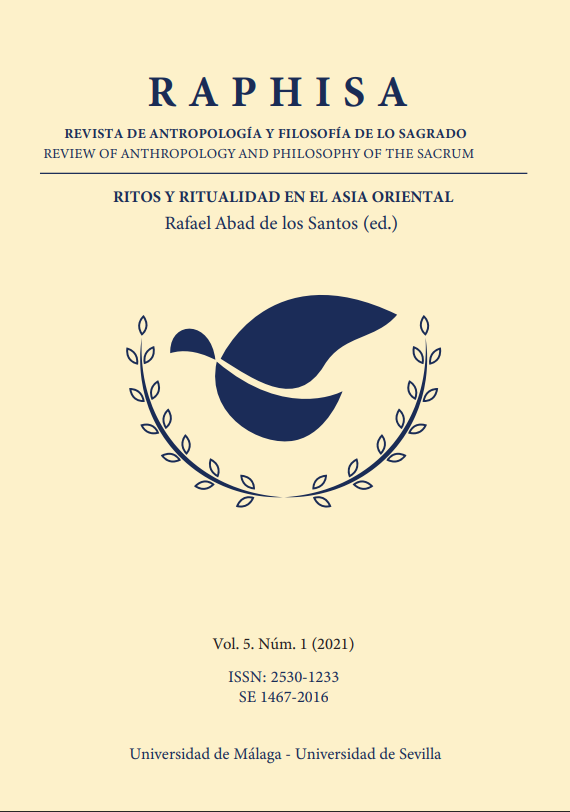Sacred sites: Symbolic configurations of the On and agricultural rituals in the Yaeyama Islands
DOI:
https://doi.org/10.24310/Raphisa.2021.v5i1.11476Keywords:
Yaeyama, utaki/On, agricultural rituals, kami.Abstract
The Yaeyama Islands, located in the southwest of the Ryukyu Archipelago, Japan, present a great variety of rituals and festivities dedicated to the deities (kami) of the communal sacred sites (utaki/On). These annual events, linked to the agricultural cycle, are carried out on the basis of specific social organizations, and have the purpose of thanking for the crops, asking for health, and ensuring fertility for the coming year. Through these acts, a range of considerations and principles linked to a worldview and a belief system are unfolded, which are perceived through conceptions of space and time, as well as symbolic forms expressed in the composition of the sacred site.
Downloads
Metrics
References
Baksheev, E. (2008). Becoming kami? Discourse on postmortem ritual deification in the Ryukyus. Japan Review, 20, 275-339.
Gillan, M. (2012). Songs from the edge of Japan. Music-making in Yaeyama and Okinawa. Nueva York: Routledge.
Guerreiro, A. (1995). Cosmology, rituals and society: preliminary observations on the religious creeds and practices in Iriomote jima. Cahiers d'Extrême-Asie, 8, 291-323.
Hateruma, E. (1988). Yaeyama no utaki shink? sh?zoku oboegaki [Notas sobre las costumbres y creencias del utaki en Yaeyama]. Bulletin of Okinawa Prefectural University of Arts Research Institute, 1, 3-25.
Hateruma, E. (1992). Yaeyama: fûdo to rekishi soshite saishi shûzoku [Yaeyama: clima, historia y costumbres rituales]. En Y. Amino (Ed.), Rettô no kami-gami: Taketomi-jima no Tanedori-sai, Kamikawa chihô no Iyomante [Dioses del archipiélago: Festival Tanedori de la isla de Taketomi, Iyomante en la región de Kamikawa] (Vol. 14, págs. 36-58). Heibonsha.
Ishigaki, H. (4 de Enero de 2019). Entrevista realizada en la isla de Taketomi.
Ishigaki, S. (2017). Yaeyama shotô no inasaku girei to minzoku [Ritual del cultivo del arroz y folclor en las islas Yaeyama]. Ishigaki: Nazansha.
Ishigaki, S. (24 de Diciembre de 2018). Entrevista a la sacerdotisa del Ushagi On, Ôkawa.
Kreiner, J. (1968). Some problems of folk-religion in the Southwest Islands (Ryûkyû). En T. Mabuchi, & M. Nobuhiro (Edits.), Folk Religion and the Worldview in the Southern Pacific (págs. 101-118). Tokyo: Keio Institute of Cultural and Linguistic Studies/Kokusai Printing.
Lebra, W. (1966). Okinawan religion. Belief, ritual, and social structure. University of Hawai'i Press.
Loo, T. M. (2014). Heritage politics. Shuri castle and Okinawa's incorporation into modern Japan, 1879-2000. Maryland: Lexington Books.
Mabuchi, T. (1976). A note on ancestor worship in "cognatic" societies. En W. Newell, & I. C. Sciences (Edits.), Ancestors (págs. 105-118). La Haya/Chicago: Mouton Publishers.
Makino, K. (1990). Yaeyama no otake: gakugakumei, yurai, saishi, rekishi [Otake de Yaeyama: nombre de otakes, origen, ritual, historia]. Ishigaki: Aman.
Morishita, K. F. (2018). A critical study of the comparison between Kami-Asagi and Tun: on the basis of the fieldwork on Okinawa Island. Journal of Asian Architecture and Building Engineering, 5(1), 29-36.
Newell, W. H. (1980). Some features of the domestic cult organization in the Southern Ryukyus and Taiwan. Asian Folklore Studies, 39(2), 23-40.
Origuchi, S. (2016). Ryukyu no shûkyô. Goma Books.
Ôshiro, K. (2018). Yaeyama, matsuri no genryû. Shichi to pûru, kitsugan [Yaeyama, el origen del festival. Shichi y pûru, kitsugan]. Ginowan: Yôjû Shorin.
Ôta, Y. (1987). Ritual as narrative: folk religious experience in the Southern Ryûkyûs (tesis doctoral). Universidad de Michigan.
Ouwehand, C. (1967). The ritual invocations of Hateruma. Asian Folklore Studies, 26(2), 63-109.
Ouwehand, C. (1985). Hateruma. Socio-religious aspects of a south-ryukyuan island culture. Leiden: E.J. Brill.
Radulescu, A. (2017). Yaeyama no minzoku to kokka taisei: Umutû yamanokami no shinwa to seichi no hensen ni shôten o atete [Folklore and national system of Yaeyama: Focusing on the transition of myth of the god of Umutu and the holy land] (tesis doctoral). Unversidad de Ryûkyû.
Røkkum, A. (1998). Goddesses, priestesses and sisters: Mind, gender and power in the monarchic tradition of the Ryukyus. Oslo: Scandinavian University Press.
Røkkum, A. (2006). Ritual and Society in Japan's Ryukyu Islands. Nueva York: Taylor & Francis.
Rots, A. (2019). Strangers in the sacred grove: the changing meanings of okinawan utaki. Religions, 10(5), 1-19.
Sawai, M. (2012). Ishigakijima no josei shûkyô-sha to chiiki no ima [Mujeres religiosas y presentes locales de la isla de Ishigaki]. En K. Matsuo, & M. N. Japonesa (Edits.), Ryûkyû ko. Kaiyô o meguru mono [El Arco de Ryûkyû. Cosas, personas y cultura alrededor del océano] (págs. 197-220). Tokyo: Iwata shoin.
Sered, S. (1999). Women of the sacred groves: Divine priestess of Okinawa. Nueva York: Oxford University Press.
Takeo, S. (2005). Festivals as processes for the construction of collective memory. Annual report of the Institute for International Studies, 3-11.
Watanabe, Y., Sato, T., Shiotsuki, R., Okano, N., & Miyashita, K. (2008). Okinawa minzoku jiten [Diccionario popular de Okinawa]. Tôkyô: Yoshikawa Kobunkan.
Downloads
Published
How to Cite
Issue
Section
License
License permitted by the journal: Public Domain. Authors retain the copyright and full publishing rights without restrictions.






